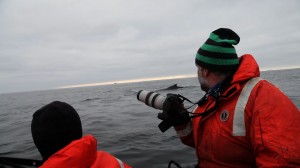My scene is about whale biologist, Dave Johnston. What really caught my attention with his work is his integration of art and science. He uses photography as a means of visually recording his research. He takes eight photographs per minute so what he is left with is basically a photographic flipbook.
I haven’t really heard of modern scientists using photography as an integral part of furthering their research like Dave, so for me that was a glimpse into a scientific realm I haven’t really imagined before. Scientific illustrations have been an integral part of science since the invention of the microscope–the use of photography shouldn’t have struck me as alien. Nonetheless, Dave’s project has opened up my eyes to the realm of the Antarctic.
I am a novice with filmmaking. Not only am I learning how to use the film editing software but I am learning about a lot of the science involved in the LTER. The reason as to why I wanted to work on this documentary was to learn about the science through nontraditional means. Listening to Oscar Schofield’s presentation in our Film Center at our Center for Digital Filmmaking was really astounding and, quite frankly, inspiring. He gave the film students a basic introduction to the science involved in the LTER. He first talked about how the LTER came into being and apparently it started off with the hypothesis that climate change in the Antarctic could be seen in the biology, predominantly with the decline and rise of bird populations. Now biology reflecting climate change is a widely accepted theory, but at the time the LTER began, it was considered radical and controversial.




 Follow the
Follow the  Subscribe to the blog RSS feed
Subscribe to the blog RSS feed